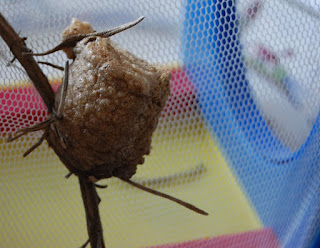OK, two blogs in one day tells you that mom is helping out BIG time so I can get some playtime in. We're at my Mimi and Poppy's house in Finksburg, MD and look what Poppy found!
We don't know what it is yet because we found it already in it's chrysalis stage. Thankfully, my sister let me borrow her habitat to keep it in for now.
Here is what we do know - the rest will have to be added later.
Found: April 10, 2011 (by Poppy)
Cocoon location on a branch of Rosemary in the garden. You will have to check back to see if and when we solve this mystery!
Just a basic BioBlog from an almost 7year old boy of all the interesting creatures I find - mostly where I live, but also on my travels and maybe even at the beach.
Sunday, April 10, 2011
Banded Woolly Bear
This one will have stages and more pictures since it is a caterpillar. Also, the format may be different too as we try to show the different stages.
These two pictures are not our own.
Borrowed from http://tinkernaturepark.blogspot.com and http://wiseacre-gardens.com
Found: April 7, 2011
Common Name: Banded Woolly Bear Caterpillar
Scientific Name: Isia isabella
Found again in our backyard, in the grass, in Hampstead, MD. I brought this one inside, and mom let me keep it. After Google, we found out that it eats grasses and broad leaves, so I got a fist full of grass and a dandelion leaf. I put the caterpillar and grass in the habitat my Mimi gave me. Over night, it made itself a cocoon.
He choose to build his cocoon right up against the door of the habitat, so this was the best picture we could get. Chrysalis stage started Friday, April 9th. If it hatches, I will let you know, but here's a preview of the Isabella Tiger Moth that is should become if all goes well!
Borrowed from http://dailyapple.blogspot.com
Clicking this link will take you away from my blog - my info came from: http://www.enchantedlearning.com/subjects/butterfly/activities/printouts/Woollybear.shtml
Friday, April 8, 2011
Destin, FL obsession - Coquina Clams
This is me on the white sandy beach of Destin, Florida. I went here with my Mimi, Poppy, Uncle, mom and Sister in March of 2011. The water was still cold, and it was breezy, but that didn't stop me from playing at the edge. Here my sister and I found these little shell creatures. Mimi had a cup with her that I used. I filled the bottom with sand, added ocean water and my new treasures. Mom let me take my temporary habitat back to our room to see what would happen, and she took a few videos.
Found on: March 19, 2011
Common Name: Coquina Clams
Scientific Name: Donax variabilis
Found: while in Destin, FL along the edge of the water.
Fun Facts:
Coquina are triangular in shape come in many colors, and their shells are hinged (known as bivalve).
Found along the beaches of the USA Atlantic Ocean and Gulf coasts.
They are filter-feeders, using siphons to eat - one celled alge, plant pieces in the sand, and detritus "(detritus is non-living particulate organic material. It typically includes the bodies or fragments of dead creatures as well as fecal material. Detritus is typically colonized by communities of microorganisms which act to decompose (or remineralize) the material". - courtesy of Wikipedia.
These little clams can be used for food - check out this video, found on youtube.com
EatTheWeeds: Episode 88
Clicking this link will take you from my blog - my information came from: http://www.britannica.com/EBchecked/topic/136997/coquina-clam
Thursday, April 7, 2011
Red-backed Salamander
Common Name: Red-backed Salamander
Scientific Name: Plethodon cinereus
Found: This salamander was in the same place as the Black Salamander. In the back yard under a wet log and leaves that were left from Fall.
FUN FACTS:
This salamander grows to about five inches long.
Red-backed Salamanders lay their eggs in a cluster, like grapes, hanging underneath a rock or inside an old log. They are born looking like mini-salamanders, about an inch long.
Like the Black Salamander, the Red-backed Salamander has no lungs and breathes through its skin which must remain wet or moist at all times. It comes out after it rains to hunt for its food. They eat arthropods (animals with exoskeletons, jointed legs, and segmented bodies).
Salamanders help plants when they tunnel through the dirt, because it breaks up and mixes up the soil which allows the plants to get the nutrients easier.
Wednesday, April 6, 2011
Black Salamander
Date Found: April 6, 2011
Common Name: Black Salamander
Scientific Name: Aneides flavipunctatus
Found: Under a piece of wood that was lying on the ground on top of wet leaves and mud.
FUN FACTS:
This salamander has no lungs. It breathes through its skin, and the tissues lining their mouths. They must keep these surfaces moist in order to respire, and so have to live in damp environments, such as beneath logs, in caves or in wet rock crevices, and only venture out in humid weather.
The Black Salamander lays its eggs on land. The babies are hatched full grown. They eat earthworms, slugs, snails, spiders and a variety of insects. They are nocturnal and hunt at night. In captivity, they can be fed crickets, earthworms and mealworms. They have 3 toes on the front feet and 4 toes on the back feet.
Be careful to wash hands before and after handling amphibians as they sometimes secrete poisons through their skin. It isn't poisonous to touch.
Subscribe to:
Posts (Atom)









